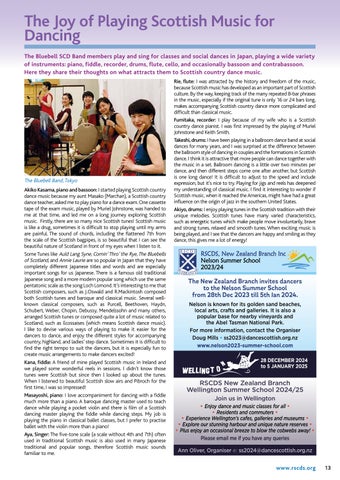The Joy of Playing Scottish Music for Dancing The Bluebell SCD Band members play and sing for classes and social dances in Japan, playing a wide variety of instruments: piano, fiddle, recorder, drums, flute, cello, and occasionally bassoon and contrabassoon. Here they share their thoughts on what attracts them to Scottish country dance music.
The Bluebell Band, Tokyo Akiko Kasama, piano and bassoon: I started playing Scottish country dance music because my aunt Masako (Marchan), a Scottish country dance teacher, asked me to play piano for a dance exam. One cassette tape of the exam music, played by Muriel Johnstone, was handed to me at that time, and led me on a long journey exploring Scottish music. Firstly, there are so many nice Scottish tunes! Scottish music is like a drug, sometimes it is difficult to stop playing until my arms are painful. The sound of chords, including the flattened 7th from the scale of the Scottish bagpipes, is so beautiful that I can see the beautiful nature of Scotland in front of my eyes when I listen to it. Some Tunes like Auld Lang Syne, Comin’ Thro’ the Rye, The Bluebells of Scotland, and Annie Laurie are so popular in Japan that they have completely different Japanese titles and words and are especially important songs for us Japanese. There is a famous old traditional Japanese song and a more modern popular song which use the same pentatonic scale as the song Loch Lomond. It’s interesting to me that Scottish composers, such as J.Oswald and R.Mackintosh composed both Scottish tunes and baroque and classical music. Several wellknown classical composers, such as Purcell, Beethoven, Haydn, Schubert, Weber, Chopin, Debussy, Mendelssohn and many others, arranged Scottish tunes or composed quite a lot of music related to Scotland, such as Ecossaises (which means Scottish dance music). I like to devise various ways of playing to make it easier for the dancers to dance, and enjoy the different styles for accompanying country, highland, and ladies’ step dance. Sometimes it is difficult to find the right tempo to suit the dancers, but it is especially fun to create music arrangements to make dancers excited! Kana, fiddle: A friend of mine played Scottish music in Ireland and we played some wonderful reels in sessions. I didn’t know those tunes were Scottish but since then l looked up about the tunes. When I listened to beautiful Scottish slow airs and Pibroch for the first time, I was so impressed! Masayoshi, piano: I love accompaniment for dancing with a fiddle much more than a piano. A baroque dancing master used to teach dance while playing a pocket violin and there is film of a Scottish dancing master playing the fiddle while dancing steps. My job is playing the piano in classical ballet classes, but I prefer to practise ballet with the violin more than a piano! Aya, Singer: The five-tone scale (a scale without 4th and 7th) often used in traditional Scottish music is also used in many Japanese traditional and popular songs, therefore Scottish music sounds familiar to me.
Rie, flute: I was attracted by the history and freedom of the music, because Scottish music has developed as an important part of Scottish culture. By the way, keeping track of the many repeated 8-bar phrases in the music, especially if the original tune is only 16 or 24 bars long, makes accompanying Scottish country dance more complicated and difficult than classical music. Fumitaka, recorder: I play because of my wife who is a Scottish country dance pianist. I was first impressed by the playing of Muriel Johnstone and Keith Smith. Takeshi, drums: I have been playing in a ballroom dance band at social dances for many years, and I was surprised at the difference between the ballroom style of dancing in couples and the formations in Scottish dance. I think it is attractive that more people can dance together with the music in a set. Ballroom dancing is a little over two minutes per dance, and then different steps come one after another, but Scottish is one long dance! It is difficult to adjust to the speed and include expression, but it’s nice to try. Playing for jigs and reels has deepened my understanding of classical music. I find it interesting to wonder if Scottish music, when it reached the Americas, might have had a great influence on the origin of jazz in the southern United States. Akiyo, drums: I enjoy playing tunes in the Scottish tradition with their unique melodies. Scottish tunes have many varied characteristics, such as energetic tunes which make people move involuntarily, brave and strong tunes, relaxed and smooth tunes. When exciting music is being played, and I see that the dancers are happy and smiling as they dance, this gives me a lot of energy!
RSCDS, New Zealand Branch Inc Nelson Summer School 2023/24
The New Zealand Branch invites dancers to the Nelson Summer School from 28th Dec 2023 till 5th Jan 2024. Nelson is known for its golden sand beaches, local arts, crafts and galleries. It is also a popular base for nearby vineyards and the Abel Tasman National Park. For more information, contact the Organiser Doug Mills • ss2023@dancescottish.org.nz www.nelson2023-summer-school.com 28 DECEMBER 2024 to 5 JANUARY 2025
RSCDS New Zealand Branch Wellington Summer School 2024/25 Join us in Wellington • Enjoy dance and music classes for all • • Residents and commuters • • Experience Wellington’s cafes, galleries and museums • • Explore our stunning harbour and unique nature reserves • • Plus enjoy an occasional breeze to blow the cobwebs away! • Please email me if you have any queries Ann Oliver, Organiser e: ss2024@dancescottish.org.nz
www.rscds.org
13
